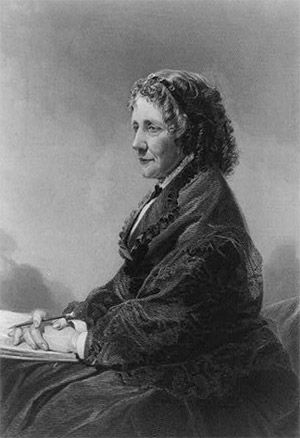Publication of Uncle Tom’s Cabin
Harriet Beecher Stowe's influential work first appeared in the National Era on June 5th, 1851.
 The most influential American novel ever written appeared first in weekly instalments between June 1851 and April 1852 in the National Era, a Washington DC periodical with an anti-slavery slant. It was a sensational success and when published in book form in 1852, sold more than 300,000 copies in the first year. Some of its characters and scenes have still not entirely vanished from the general consciousness: the incorrigible Topsy, who ‘just growed’, the sadistic slave-driver Simon Legree, Eliza’s escape to freedom with her baby across the ice on the Ohio River and the good-hearted, loyal Uncle Tom himself, whose name was to become a term of contempt. The book was translated into more than twenty languages, was turned into popular stage versions and inspired songs and merchandising spin-offs. Such was its impact in arousing feeling against slavery that it has been credited with helping to cause the US Civil War.
The most influential American novel ever written appeared first in weekly instalments between June 1851 and April 1852 in the National Era, a Washington DC periodical with an anti-slavery slant. It was a sensational success and when published in book form in 1852, sold more than 300,000 copies in the first year. Some of its characters and scenes have still not entirely vanished from the general consciousness: the incorrigible Topsy, who ‘just growed’, the sadistic slave-driver Simon Legree, Eliza’s escape to freedom with her baby across the ice on the Ohio River and the good-hearted, loyal Uncle Tom himself, whose name was to become a term of contempt. The book was translated into more than twenty languages, was turned into popular stage versions and inspired songs and merchandising spin-offs. Such was its impact in arousing feeling against slavery that it has been credited with helping to cause the US Civil War.
The author, Harriet Beecher Stowe, a diminutive New Englander from a high-minded, intellectual, clerical background, was nearing her fortieth birthday when the book came out. Her father was a celebrated Congregationalist preacher, Lyman Beecher. Her husband and all her brothers were ministers, and her literary output was dedicated to inculcating Christian values. She began writing essays, sermons and temperance tales and after marrying a widower, the hypochondriac biblical scholar Calvin Ellis Stowe (‘of goblin origin decidedly’, she once wrote), continued her writing, which brought in badly needed extra income. They lived in Cincinatti, across the Ohio River from slave-owning Kentucky, and she met fugitive slaves and learned more about life in the South.
In 1849 her son, Samuel Charles, eighteen months old, died of cholera. It was then, she wrote later, that she discovered at first hand what a slave mother might feel when her child was taken away from her; she began to write Uncle Tom’s Cabin in 1851 after she, her husband and six surviving children had moved north to Maine.
The book started appearing in print while Mrs Stowe was still writing it and she had trouble keeping up. In July 1851 she was still casting round for more information about life on the Southern cotton plantations, from the black abolitionist Frederick Douglass. She only failed to send an instalment in on time once, however, and as she went on with her story the words began to pour out in a gusher of what she felt was divine inspiration. ‘The Lord Himself wrote it,’ she used to say afterwards. ‘I was but an instrument in His hand.’
The book made Mrs Stowe an international celebrity and a hated figure in the South. In 1853 she published A Key to Uncle Tom’s Cabin, a non-fiction riposte to critics who accused her of exaggerating slavery’s cruelties. On a tour of Britain she made friends among the great and good, was cheered at anti-slavery meetings and collected ample donations for the cause. Returning home, she published another anti-slavery novel in 1856, Dred: A Tale of the Great Dismal Swamp. Later came more novels as well as children’s stories and religious poetry, and she helped to found the prestigious Atlantic Monthly magazine, to which she contributed a regular column on household matters, undeterred by her husband’s complaints about her domestic incompetence. Later she took up feminist causes, writing to George Eliot that the emancipation of slaves must be followed by the emancipation of women. She was a friend of Lady Byron and in 1869 she published in Atlantic Monthly ‘The True Story of Lady Byron’s Life’, an attack on female sexual slavery in which, blushing but determined, she wrote openly of Byron’s incest with his half-sister. She followed up with a book, Lady Byron Vindicated, in the following year. She was denounced as a pornographer and deluged with torrents of abuse in the press, while Atlantic Monthly lost 15,000 outraged subscribers and was almost destroyed. Her reputation was shattered, but she published three more novels before her death in 1896.




